New Rules For the Millennium
Effective January 1, 2000
by David Dellenbaugh
Just when you thought you had learned all the new rules and last yearís changes to the new rules, the rulebook is morphing again. But donít worry - the changes are relatively minor, and they clarify or improve a few of the rules we have been using. There are several changes from the ISAF meetings earlier this month, but the most significant are two changes to Part 2 (When Boats Meet). Those are the one Iíve explained here, and they go into effect on January 1.
Mark-rounding clarity
The 1997-2000 Racing Rules of Sailing were generally a welcome improvement over the previous rules. However, one rule that wasnít always so clear was 18.2(b).
\
For example, the rule said that rule 10 didnít apply, but why didnít it mention rule 11? Rule 18.2(b) no longer applied when the boat clear ahead tacked, but what happened when that boat went just beyond head to wind? Did the clear ahead boatís obligations under rule 16 override her rights under 18.2(b)? Because these kinds of questions have come up during the past three years, the rulemakers voted for a new, improved rule 18.2(b).
The intent of this rewritten rule is not to change the way we play the game, but simply to clarify what most sailors thought the rule meant all along. That is, when two non-overlapping boats approach a mark, the one that is clear astern at the two-length zone must keep clear during the entire rounding.
Thatís why the rule now says specifically that rules 10, 11 and 18.2(a) do not apply. Itís also the reason why this rule now contains the only exception to rule 16 anywhere in the rulebook.
The problem with the old rule was that a boat clear astern could get a late inside overlap, continue to keep clear as required, and have the protection of rule 16. If the boat could then get her bow alongside the mark, the boat that was clear ahead would have to allow the other boat to round the mark. This has now been fixed by 18.2(b)ís second sentence.
In summary, the rule works like this: If you reach the two-length zone clear ahead, you can make any kind of rounding you want (unless you go out of the zone), and a boat behind must keep clear until you both have passed the mark. When youíre clear astern you must keep clear during the rounding, even if youíre on starboard tack or to the leeward. And there are no longer any loopholes.
|
18.2 Giving Room; Keeping Clear New 1/1/00
(b) If a boat is clear ahead when she reaches the two-length zone, the boat then clear astern shall thereafter keep clear. Rules 10, 11 and 18.2 (a) do not apply, and rule 16 applies only if the right-of-way boat changes course away from the mark or obstruction. If the right-of-way boat passes head to wind, rule 13 applies and this rule no longer does.
18.2 Old
(b) If a boat is clear ahead when she reaches the two-length zone, the boat clear astern shall keep clear even if an overlap is established later. Rule 10 does not apply. If the boat clear ahead tacks, rule 13 applies and this rule no longer does.
|
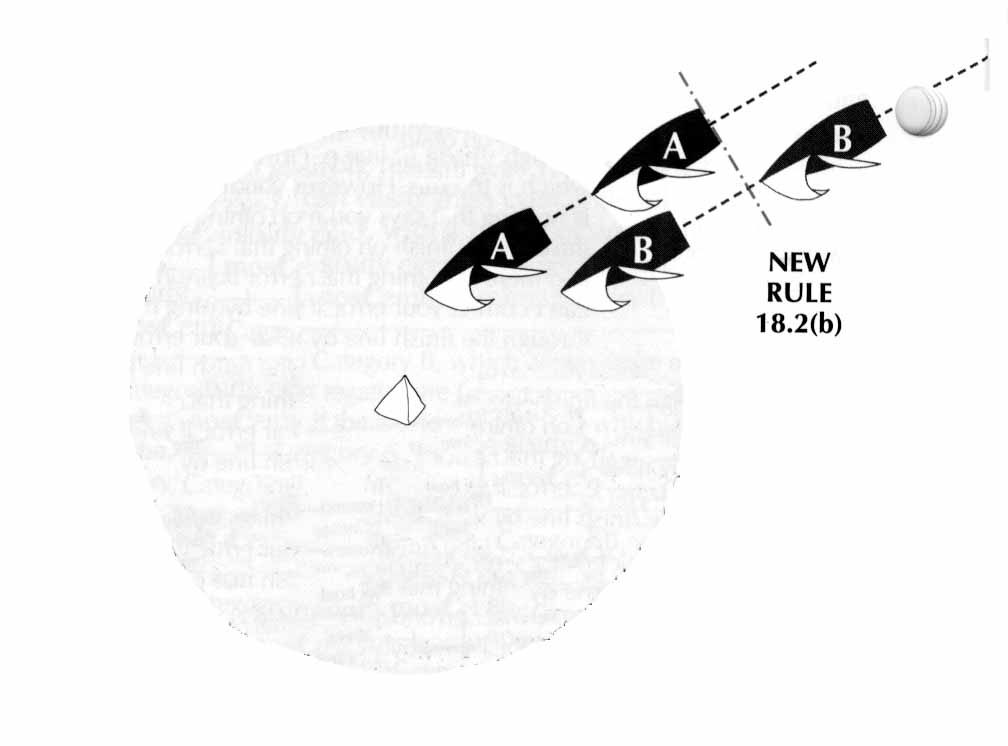 |
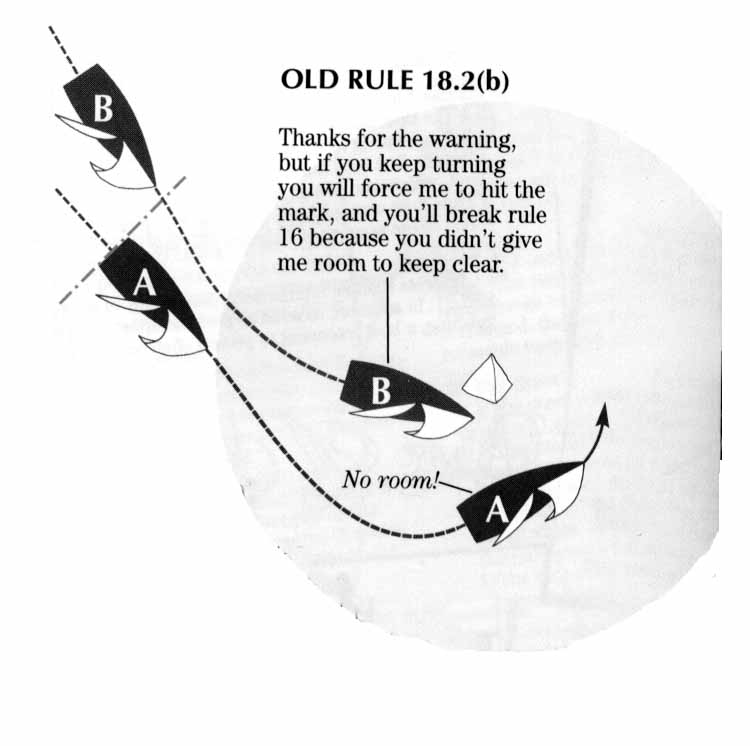 |
| Under the new rule when A reaches the two-length zone, she is clear ahead of B. However, B is going faster and soon establishes a leeward overlap on A. At this point, which boat holds the right of way?
If there was no mark, B would have rights because A (the windward boat) is required to keep clear of her. However, since the boats are about to pass a mark, rule 18 applies. A got to the zone clear ahead, so we have to look at new rule 18.2b (see box).
This rule clearly says 1) B must keep clear of A during their rounding; and 2) rule 11 (windward-leeward) does not apply. So even though B is a leeward boat, she must keep clear.
|
Under the old rule 18.2b, a boat (B) that was clear astern at the 'zone' was not entitled to room from a boat clear ahead (A). But if B was able to stick her bow between A and the mark (when A was turning and there was still room for B), A might not be able to "shut the door."
That's because rule 16 says that when A (the right-of-way boat) changes course, she must give B room to keep clear. Once B's bow overlaps the mark, any further course change by A would force B to hit the mark, and that would mean B was unable to keep clear (i.e. A broke rule 16). This is why new rule 18.2b turns off rule 16 when the right-of-way boat is turning toward the mark. |
An ďanti-huntingĒ rule
When the current racing rules went into effect in 1997, the new rule 16 (Changing Course) was slightly controversial. On the plus side, the rule was simpler and more straightforward than before, and it applied everywhere on the race course. On the other hand, some sailors thought it gave too much carte blanche to right-of-way boats.
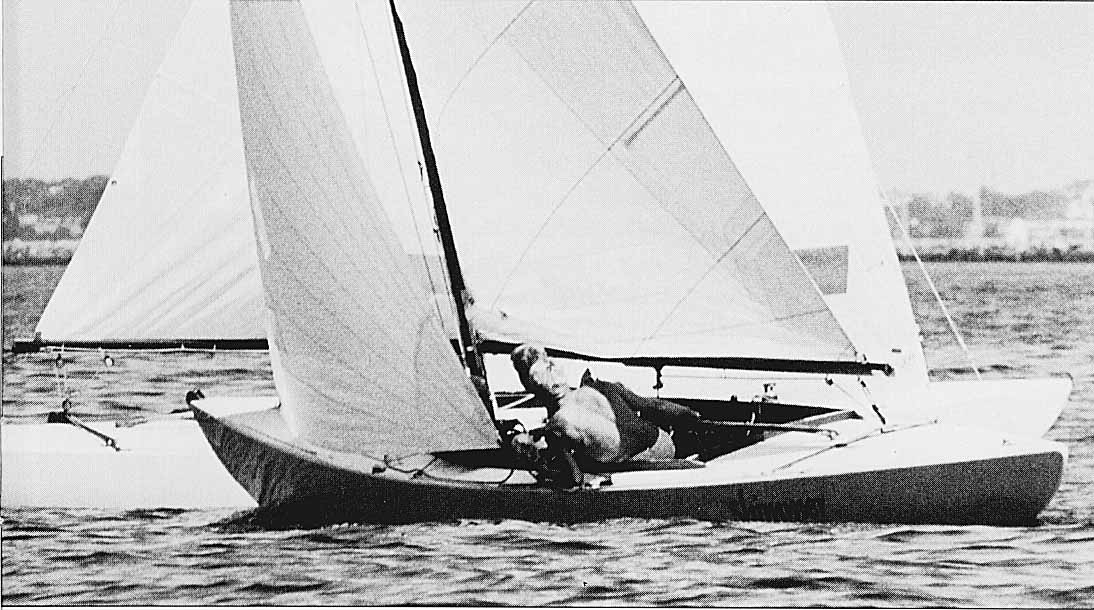 |
| Prior to this rule change, a starboard tacker could change her course, or ďhuntĒ, when she was very close to a port
tacker. All she had to do was make sure she gave the other boat a chance to keep clear. In the future, however, the right-of-way boat must be careful. If she changes her course and this causes the give-way boat to change course immediately, then the right-of-way boat is wrong, even if the other boat is able to keep clear. |
Even before 1997, there had been a number of proposals trying to limit the amount that a right-of-way boat could ďhunt.Ē These ideas were not incorporated into the new rules at first, but in the last three years there has been more support of a limit on hunting. As a result, the issue was brought up again at the recent ISAF meetings, and the new rules text below was narrowly approved. It will take effect on January 1, 2000.
Basically, the current rule 16 remains exactly the same as before (except it has been renumbered as 16.1). That is, when a right-of-way boat changes course, she must give the other boat room to keep clear.
However, a new limitation has been added as rule 16.2 This addition applies only after the starting signal, and it comes into play only between boats on opposite tacks.
It says that a right-of-way boat, in addition to the requirements of 16.1, must not change her course in a way that requires the other boat to change course immediately to keep clear. If the give-way boat has to change course immediately, then the right-of-way boat changed course too close and broke rule 16.2 The net result is that port-tack boats have more protection when theyíre near starboard tackers. And starboard tackers must be more careful when they change course close to port tackers.
16 Changing Course New 1/1/00
16.1 When a right-of-way boat changes course, she shall give the other boat room to keep clear.
16.2 In addition, when after the starting signal a port-tack boat is keeping clear of a starboard-tack boat, the starboard-tack
boat shall not change course if as a result the port-tack boat would immediately need to change course to keep clear. |
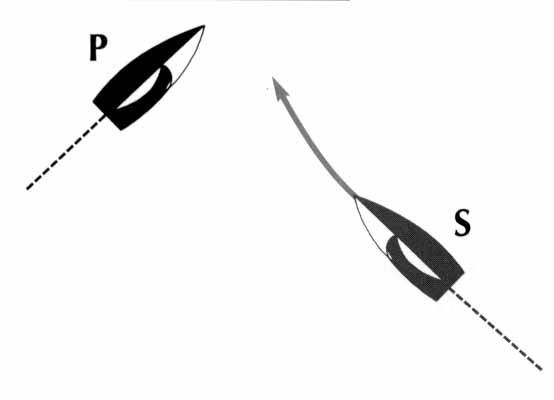 |
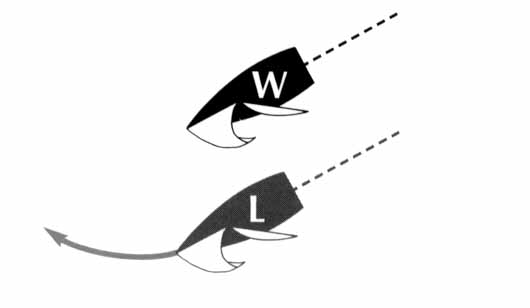 |
The new rule 16.2 does not actually
prohibit hunting, but it does make changing course near another boat more risky. Under the old version
of rule 16, a starboard tacker (S) could change her course quite close to a port tacker (P). She
just had to give P room to keep clear.
Now itís different. Whenever S changes course, she still has to give P room to keep clear, but
that by itself is not enough. S also has to make sure her course change does not require P to make an immediate course change of her own to keep clear. S can still ďhuntĒ P, but now she must give P more time and space to respond. |
The new rule 16.2 applies only after the starting signal, and only to boats that are on opposite tacks. When boats are on the same tack, the right-of-way boat is limited only by rule 16.1, which is the same as before.
In the situation above, the leeward boat (L) can luff the windward boat (W) fairly quickly, even though the boats are quite close. Of course, L must give W room to keep clear, but if Lís course change causes W to change course immediately, thatís OK because rule 16.2 doesnít apply here. |
Back to Articles
About Sailing Breezes Magazine
Please send us your comments!!
All contents
are copyright (c) 1999
by Northern Breezes, Inc. All information contained within is deemed reliable but carries
no guarantees. Reproduction of any part or whole of this publication in any form by
mechanical or electronic means, including information retrieval is prohibited except by
consent of the publisher.




